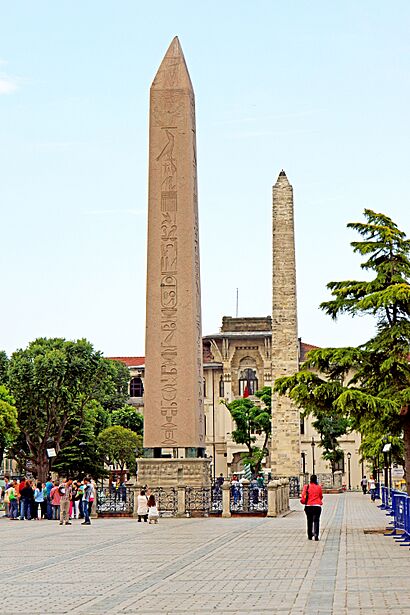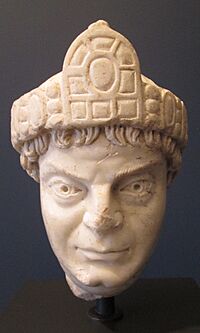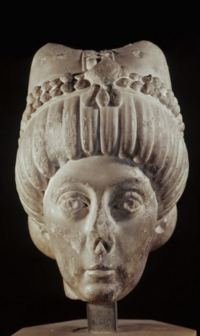Nika riots facts for kids
Quick facts for kids Nika riots |
|||
|---|---|---|---|

Site of the Hippodrome of Constantinople in Istanbul
|
|||
| Date | January 532 CE | ||
| Location | |||
| Caused by | See causes | ||
| Goals | Free demes' leaders, overthrow Justinian | ||
| Methods | Widespread rioting, property damage, murder, arson | ||
| Resulted in | Military action by imperial government leading to the escalation and militarization of the riots | ||
| Parties to the civil conflict | |||
|
|||
| Lead figures | |||
|
|
|||
| Casualties | |||
| Death(s) | 30,000 rioters killed | ||
The Nika riots (Greek: Στάσις τοῦ Νίκα, romanized: Stásis toû Níka), also called the Nika revolt, were a huge uprising against the Byzantine emperor Justinian I. They happened in the city of Constantinople over one week in 532 CE. Many people consider them the most violent riots in the city's history. Nearly half of Constantinople was burned or destroyed, and thousands of people lost their lives.
Contents
What Led to the Nika Riots?
The Roman empire had groups called demes. These groups supported different teams in sports, especially chariot racing. There were four main teams, known by the color of their uniforms: the Blues, Greens, Reds, and Whites. By the 500s, only the Blues and Greens were very powerful.
Emperor Justinian I used to support the Blues. But when he became emperor, he tried to be fair to both sides. He wanted to limit the power of these groups. However, his past support for the Blues made people think he wasn't truly neutral. This made him seem less in control of the capital city before 532.
The demes became a way for people to show their feelings about social and political issues. They were like a mix of street gangs and political parties. They often shouted their demands to the emperor during races. The city's guards couldn't keep order without the demes' help. Rich families in the city also supported these groups. Some of these families even thought they should be emperor instead of Justinian.
In 531, some members of the Blues and Greens were arrested. They were involved in violence after a chariot race. Most of the arrested people were put to death. But on January 10, 532, two of them, one Blue and one Green, managed to escape. They found safety in a church, surrounded by an angry crowd.
Justinian was worried. He was trying to make peace with the Persians after a war. Now, he faced a big problem in his own city. So, he announced a chariot race for January 13. He also changed the sentences of the two escaped men to prison time. The Blues and Greens demanded that the two men be fully pardoned. When Justinian refused, both groups united. They started shouting "Nika!" (meaning "Win!" or "Conquer!"). Then, they began to riot.
Why the Riots Happened
Emperor Justinian I and his top officials, John the Cappadocian and Tribonian, were not popular. People disliked them because of high taxes. There were also claims that John and Tribonian were corrupt. John was also known for treating people who owed money very harshly.
Justinian and John also cut spending on government services. They tried to stop corruption in the government. John was especially disliked by rich senators. His new tax rules hit the wealthiest people hard. This likely led to senators influencing the riots. Many nobles had lost power and money because of these changes. They joined the Greens.
Justinian also tried to reduce the power of both the Blues and Greens. The Greens saw this as unfair, like the changes to the government. The Blues felt betrayed by Justinian.
The Roman law code was very important to people. It showed that Romans were "civilized" and chosen by God. An emperor who made good legal changes was seen as a good ruler. If they didn't, it was seen as a bad sign. Justinian made big legal changes very quickly.
However, before the Nika riots in January 532, the legal changes slowed down. Also, Justinian was losing a war against the Persian Empire. Early victories had made him look good, but a defeat in 531 hurt his reputation. The rich families didn't like the legal changes from the start. These changes made it harder for them to use old laws to avoid bad court rulings.
Also, Justinian and his wife Theodora came from humble beginnings. The Greens were a group with different religious beliefs. They also represented people who had money but didn't own land. Justinian was neither of these things. So, when Justinian refused to pardon the two arrested men, it made people even angrier. The groups became more violent, setting fires and attacking guards.
Another reason for the riots' strength was that the demes had been very powerful for a long time. Justinian's actions made their rivalries even stronger. For three decades before Justinian, these groups had almost no limits. This made it easier for them to work together against the emperor. Their great power, combined with their anger, led to the Nika riots. It was also unusual for the two groups to work together and become so organized, which made the uprising very serious.
The Riots Begin
The exact timing of these riots isn't perfectly clear. We learn about them from different historical writings. At first, the rioters probably didn't plan to remove Justinian from power. The early days were more like the usual violence seen from these groups. This was made worse by the anger over the escaped criminals. Their goal was to free the arrested rioters. Usually, riots were a way to hold the emperor accountable. They showed him what the people wanted. But in the Nika riots, Justinian's promises didn't calm the crowd. Rich senators likely used this chance to try and get rid of Justinian. These riots were similar to others at the time, but they became much more organized and violent. People often threw stones, which Justinian had banned in 527.
On January 13, 532, an angry crowd gathered at the Hippodrome for the races. The Hippodrome was right next to the palace. This meant Justinian could watch the races safely from his royal box. From the very beginning, the crowd yelled insults at Justinian. By the end of the day, the chants changed. Instead of "Blue" or "Green," everyone shouted Nίκα ("Nika", meaning "Win!" or "Conquer!"). The crowds then broke out and began attacking the palace. For the next five days, the palace was under attack. Fires started during the chaos destroyed much of the city. This included the city's most important church, the Hagia Sophia. Justinian later rebuilt it.
It's thought that on January 14, the second day of the riots, Justinian offered more races. He hoped this would calm the rioters. But it didn't stop the violence. The crowd ignored his pleas. In the past, emperors had canceled races to avoid making tensions worse.
Some of the senators saw this as a chance to overthrow Justinian. They didn't like his new taxes or his lack of support for the nobility. The rioters, now armed and likely controlled by their allies in the Senate, also demanded that Justinian fire two officials: John the Cappadocian and Tribonian. Then, they declared a new emperor, Hypatius. He was a nephew of a former emperor, Anastasius I. Some historians think Justinian might have even caused the riots on purpose. This would make his political enemies, like Hypatius, show themselves. However, this idea is not widely accepted.
Justinian thought about running away. But his wife, Empress Theodora, convinced him to stay. She is famous for saying, "Those who have worn the crown should never survive its loss. Never will I see the day when I am not saluted as empress." She also reportedly said, "Purple makes a fine winding sheet." This means that dying as an emperor is better than living without the crown. While this speech might not be her exact words, it shows the strong discussions that happened in the palace. Some recent studies suggest Justinian might have left the palace for a short time. The reason for his leaving is debated. Some believe it was due to panic, while others think he wanted to get more troops.
Justinian then made a plan with Narses, a trusted official, and generals Belisarius and Mundus. Narses, carrying a bag of gold from Justinian, entered the Hippodrome alone. He went to the Blues' section. He reminded them that Justinian had always supported them over the Greens. He also pointed out that Hypatius, the new emperor they had crowned, was a Green supporter. Narses gave them the gold. The Blue leaders talked quietly and then spoke to their followers. In the middle of Hypatius's coronation, many Blues left the Hippodrome. The Greens stayed. Then, Justinian's troops, led by Belisarius and Mundus, stormed into the Hippodrome. They attacked everyone remaining, whether they were Blues or Greens.
What Happened After the Riots?
Around 30,000 people were killed during the riots. Many likely died from being trampled in the chaos, not just by soldiers. Justinian had Hypatius put to death. He also sent away the senators who had supported the riot. However, some officials Justinian had fired because of the rioters' demands, like John the Cappadocian, were later given their jobs back.
After the riots, Justinian rebuilt Constantinople and the Hagia Sophia. He was then able to rule without major uprisings until the very end of his reign. Some believe that if earlier emperors had been as inconsistent with the chariot factions as Justinian, they might have faced similar "Nika" riots.




